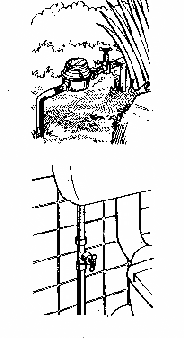 |
| Plumbing is usually a job for the professionals. However, in an emergency plastic pipes and fittings can be joined quite simply. Just apply solvent and press surface together. Then affix so they can do the job they were made for. |
 |
|
plumbing emergencies...
|
||
|
If a major plumbing disaster happens at home, water pouring in everywhere can do a great deal of damage before a plumber can get there. If you and your family know what to do in such emergency, you can prevent much damage from occurring. In any case, if you don't already know them, make a list of emergency telephone numbers for the plumber, the water board or similar authority, as well as gas and oil services if you required them. The first and most important thing to do in any emergency is to cut of the water supply. Once this is done, you can take time to locate the problem and do something about it. Now, before you really have to, make a tour of the house and locate the water cut-off valves. Make sure everyone in the family is familiar with them. The main valves are the most important. It is usually located close to where the water supply enters you property. The meter may be attached to it or nearby. See Diagram (A). Other plumbing fixtures should ideally have their own cut-off valves Diagram (B) but not all are that well equipped. Once you locate the cut-off points mark them clearly and make sure everyone knows witch way to turn them to cut-off the water supply quickly. All valves especially the main one, should be checked regularly to ensure they work effectively and do not leak. Valves, which get little use, tend to corrode and it is better to replace them in your own time then find out in an emergency that the valve does not turn. Penetrating oil can be applied to stubborn valves to get them turning again. In the event of flooding, if there is any chance of water coming in to contact with electrical components (a fatal combination), switch off the main power source to the house before attempting to deal with the water. In any case, always cat of the heating source to the water heater if the tank is to be drained. Refill the tank before turning the heater back on. If pipes burst above the ceiling, the resulting body of water can cause the ceiling to collapse. Use a bradawl to puncture the ceiling in several places and put saucepans and buckets underneath to catch the drips. In rural and southern areas, pipes located close to outside walls and under ceiling can sometimes freeze if they are not lagged (wrapped in insulation). If a pipe freezes, use hot water, hot cloths or a heat source such as hair dryer to heat the pipes. Always start from the point nearest the tap and work backwards. Be very careful using a blowtorch, especially on copper pipe, as this heats the water in the pipe and generates steam, which could cause an explosion. If you are repairing pipes, and a blowtorch is needed to do same soldering, always remove water from pipe before commencing. |
||